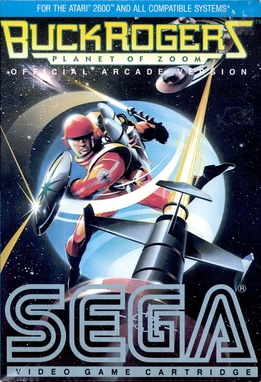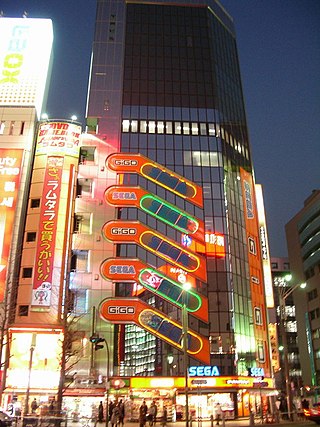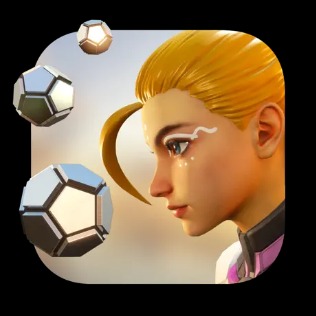
A platformer is a sub-genre of action video games in which the core objective is to move the player character between points in an environment. Platform games are characterized by levels with uneven terrain and suspended platforms of varying height that require jumping and climbing to traverse. Other acrobatic maneuvers may factor into the gameplay, such as swinging from vines or grappling hooks, jumping off walls, gliding through the air, or bouncing from springboards or trampolines.
Star Fox is an arcade style rail shooter, space flight simulator, and third person action-adventure video game series created by Shigeru Miyamoto, produced and published by Nintendo. The games follow the Star Fox combat team of anthropomorphic animals, led by chief protagonist Fox McCloud. Gameplay involves many adventures around the Lylat planetary system in the futuristic Arwing fighter aircraft, in other vehicles, and on foot. The original Star Fox (1993) is a forward-scrolling 3D rail shooter, but later games add more directional freedom.
Shoot 'em ups are a sub-genre of action games. There is no consensus as to which design elements compose a shoot 'em up; some restrict the definition to games featuring spacecraft and certain types of character movement, while others allow a broader definition including characters on foot and a variety of perspectives.

Star Fox 64, known as Lylat Wars in the PAL regions, is a 1997 3D rail shooter video game developed and published by Nintendo for the Nintendo 64. It is the second installment in the Star Fox series and a reboot of the original Star Fox for the Super Nintendo Entertainment System.

Space Harrier is a third-person arcade rail shooter game developed by Sega and released in 1985. It was originally conceived as a realistic military-themed game played in the third-person perspective and featuring a player-controlled fighter jet, but technical and memory restrictions resulted in Sega developer Yu Suzuki redesigning it around a jet-propelled human character in a fantasy setting. The arcade game is controlled by an analog flight stick while the deluxe arcade cabinet is a cockpit-style linear actuator motion simulator cabinet that pitches and rolls during play, for which it is referred as a taikan (体感) or "body sensation" arcade game in Japan.

Panzer Dragoon is a 1995 rail shooter game for the Sega Saturn, developed and published by Sega. It is the first game in the Panzer Dragoon series. The game follows hunter Keil Fluge, who becomes the rider of a powerful dragon. The player moves an aiming reticle and shoots enemies while the dragon flies through 3D environments on a predetermined track.
Shooter video games or shooters are a subgenre of action video games where the focus is almost entirely on the defeat of the character's enemies using the weapons given to the player. Usually these weapons are firearms or some other long-range weapons, and can be used in combination with other tools such as grenades for indirect offense, armor for additional defense, or accessories such as telescopic sights to modify the behavior of the weapons. A common resource found in many shooter games is ammunition, armor or health, or upgrades which augment the player character's weapons.

Xevious is a vertically scrolling shooter arcade video game developed and published by Namco in 1982. It was released in Japan by Namco and in North America by Atari, Inc. Controlling the Solvalou starship, the player attacks Xevious forces before they destroy all of mankind. The Solvalou has two weapons at its disposal: a zapper to destroy flying craft, and a blaster to bomb ground installations and enemies. It runs on the Namco Galaga arcade system.

Buck Rogers: Planet of Zoom, known as Zoom 909 in Japan, is a pseudo-3D rail shooter released as an arcade video game by Sega in 1982. The player controls a spaceship in a third-person perspective, adapting the three-dimensional perspective of Sega's earlier racing game Turbo (1981) for the space shoot 'em up genre. It uses the Buck Rogers license, referencing the space battles, though Buck himself is never seen.
The following article is a broad timeline of arcade video games.

Panzer Dragoon Orta is a rail shooter game for the Xbox, developed by Smilebit and published by Sega. The fourth Panzer Dragoon game, it was released in Japan in 2002 and in North America and Europe in 2003. The story follows a girl, Orta, who is freed by a dragon and embarks on a quest to prevent the abuse of ancient technology. The gameplay features the player moving an aiming reticle and shooting enemies while the dragon flies through 3D environments on a predetermined track.

Starblade is a 1991 3D rail shooter arcade game developed and published by Namco. Controlling the starfighter FX-01 "GeoSword" from a first-person perspective, the player is tasked with eliminating the Unknown Intelligent Mechanized Species (UIMS) before they wipe out Earth. Gameplay involves controlling a crosshair with a flight yoke stick and destroying enemies and their projectiles before they inflict damage on the player.

Panzer Dragoon is a series of video games developed by Sega. The first three games—Panzer Dragoon (1995), Panzer Dragoon II Zwei (1996), and Panzer Dragoon Saga (1998)—were produced by Sega's Team Andromeda for the Sega Saturn. The fourth, Panzer Dragoon Orta (2002), was developed by Sega's Smilebit team for the Xbox. Spin-offs include Panzer Dragoon Mini (1996) for the handheld Game Gear in Japan. A remake of Panzer Dragoon was released in 2020.

Galaxy Force is a rail shooter video game developed and released by Sega for arcades in 1988. The player assumes control of a starship named the TRY-Z, as it must prevent the Fourth Empire from taking over the entire galaxy. Gameplay involves shooting down enemies using either a laser shot or a limited supply of heat-seeking missiles, all while avoiding collision with projectiles or obstacles and making sure the ship's energy meter doesn't fully deplete. It ran on the Sega Y Board arcade system, and was released with a motion simulator cockpit arcade cabinet version like previous Sega Super Scaler games.
Light-gun shooter, also called light-gun game or simply gun game, is a shooter video game genre in which the primary design element is to simulate a shooting gallery by having the player aiming and discharging a gun-shaped controller at a screen. Light-gun shooters revolve around the protagonist shooting virtual targets, either antagonists or inanimate objects, and generally feature action or horror themes and some may employ a humorous, parodic treatment of these conventions. These games typically feature "on-rails" movement, which gives the player control only over aiming; the protagonist's other movements are determined by the game. Games featuring this device are sometimes termed "rail shooters", though this term is also applied to games of other genres in which "on-rails" movement is a feature. Some, particularly later, games give the player greater control over movement and in still others the protagonist does not move at all. On home computer conversions of light-gun shooters, mouse has been often an optional or non-optional replacement for a light gun.

Sin and Punishment is a rail shooter video game co-developed by Treasure and Nintendo for the Nintendo 64, and originally released only in Japan in 2000. Its story takes place in the near future of 2007 when war breaks out as humanity is struggling with a global famine. The player takes on the roles of Saki and Airan as they fight to save Earth from destruction. The game employs a unique scheme that uses both the D-pad and control stick on the Nintendo 64 controller, allowing players to maneuver the character while simultaneously aiming the targeting reticle. The player must shoot at enemies and projectiles while also dodging attacks to survive and progress through the game.

Video games are a major industry in Japan, and the country is considered one of the most influential in video gaming. Japanese game development is often identified with the golden age of video games and the country is home to many notable video game companies such as Nintendo, Sega, Taito, Bandai Namco Entertainment, Capcom, Square Enix, Konami, NEC, SNK, and formerly Sony Computer Entertainment. Japan is currently the third largest video game market in the world after China and the United States.

Thunder Ceptor is a 3D rail shooter arcade game that was released by Namco in 1986. It usurped both Libble Rabble and Toy Pop as the company's most powerful 8-bit arcade games, was the first game from them to use an analogue (360-degree) joystick. A stereoscopic 3-D sequel, 3-D Thunder Ceptor II, was released towards the end of the year.
Heavy Fire is a series of on-rails arcade shooter video games developed by Polish video game developer Teyon between 2010 and 2013 and Anshar from 2018 to present. The series includes five games: Heavy Fire: Special Operations (2010), Heavy Fire: Black Arms (2011), Heavy Fire: Afghanistan (2011), Heavy Fire: Shattered Spear (2013), and Heavy Fire: Red Shadow (2018).

Air Twister is a rail shooter video game developed and published by YS Net and released on June 24, 2022 for iOS and macOS via Apple Arcade. Versions for Nintendo Switch, PlayStation 4, PlayStation 5, Xbox One, and Xbox Series X/S were released on November 10, 2023.













